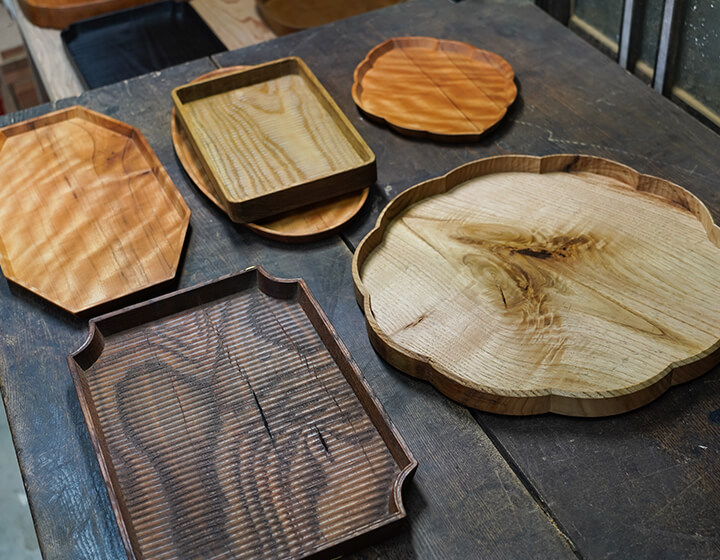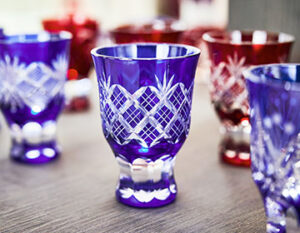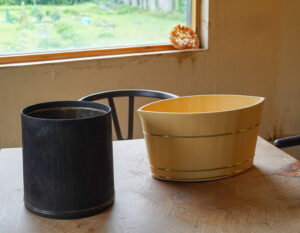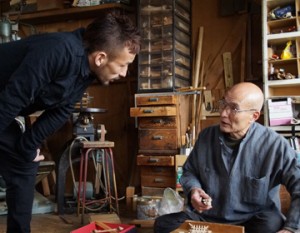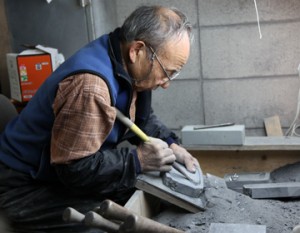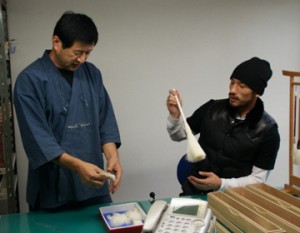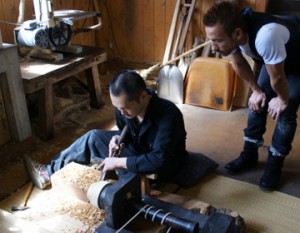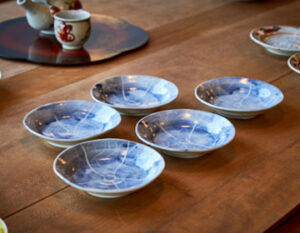Calm and gentle, with a solid sense of presence. The wooden trays created by Shibaji Ochiai, a woodworker, have the power to transform a landscape just by placing them there. We visited his workshop at the foot of Mt. Hira in Shiga Prefecture, where his works come in a variety of colors and shapes, and where he continues to receive orders from galleries and select stores nationwide.
Facing each piece one by one at the workshop in the forest in Shiga Prefecture

Minamikomatsu, Otsu City is located at the foot of Mount Hira on the west side of Lake Biwa. Mr. Ochiai’s workshop is located in a quiet forest with a clear stream running nearby. The site is also home to the workshop of his wife, Sachiko Yano, a maki-e and lacquer craft artist. Many of the houses that stand in the vicinity are vacation homes with few people coming and going, making it a perfect environment for the artist couple to concentrate on their work.
The northern area of Otsu City is home to many immigrants. Some people are engaged in manufacturing.
Incidentally, the northern part of Otsu City in Shiga Prefecture, where the Ochiai’s workshop is located, is close to the large scale nature of Hira Mountain and Lake Biwa, while Kyoto is only a 30-minute train ride away. The area is known for the large number of immigrants from outside the prefecture, especially those of child-rearing age. In addition, some of the newcomers are engaged in manufacturing, and the area has been attracting a bit of attention in recent years.
The word “craftsmanship” covers a wide range of activities, including artists like Mr. and Mrs. Ochiai, gallery and restaurant operators, designers and writers, and new farmers, etc. Mr. Ochiai, who is from Kyoto, chose this location for his workshop 10 years ago by chance. He says he likes living here, where nature is close by and it is easy to get out to the city, because it provides a good stimulus for his life as a writer, which tends to be solitary while he works.
He never took up an apprenticeship, but established his own style as a woodworker in his own way.
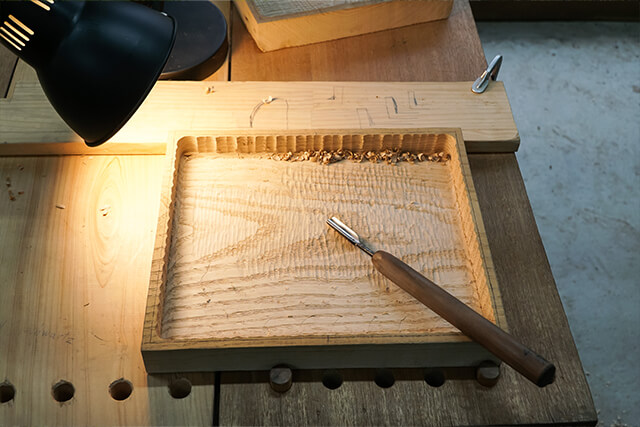
In 2000, Mr. Ochiai completed the lacquerware course of the Kyoto City Training Program for Traditional Industry Technicians, and in 2001, he learned the basics of woodworking at awoodworkingschool run by the Jyurinsha woodworking shop in Kyoto’s Minami Ward, which was known for its famous woodworkers. The following year, he expanded his style by learning the woodworking wheel from the late Uzuo Ogura in Eigenji, Shiga Prefecture, known as the home of woodworkers.
I was not born into a family of traditional craftsmen, so I entered the world of woodworking without knowledge or tools. I didn’t have the opportunity to apprentice myself to anyone in particular, so I guess you could say that I created my own style using the techniques and knowledge I learned from many people in different places,” he recalls.
From lacquered bowls to trays. The enjoyment of creation has expanded.
Mr. Ochiai, who studied lacquer ware in Kyoto, says that when he first started his career, he mainly made lacquered bowls. However, he says that he began to feel ” stuck” with the bowls he was making.
The reason, he says, is that it was difficult to add original individuality to bowls whose size, shape, and use were fixed to some extent. Rather than designing by painting or lacquering, Mr. Ochiai wanted to pursue expression by utilizing the individuality and texture of the wood, and began to explore options other than lacquered bowls.
One of the major clues he found was the ” kurimono ” technique he learned at the Jyurinsha. Using the technique of kurimono, in which a single solid piece of wood is carved out with a chisel and a planer, Ochiai creates trays in a variety of colors, shapes, sizes, and types of wood.
While it is important to know the characteristics of each type of wood and how to handle it, including its characteristics and how to cut it, there are relatively few other rules governingthe making of wooden trays, which allows for a high degree of freedom. He finds this appealing, and says that he enjoys making trays even more than before.
Trays that are “free” for the user as well
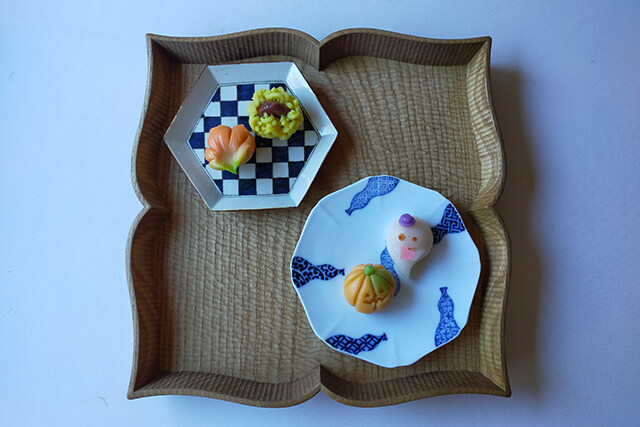
It seems that Mr. Ochiai’s wooden trays are just as free and exciting for the user as they are for the creator himself.
A search for “#Ochiai Shibaji” on social networking sites reveals that some people use the trays in the style of a Japanese course meal, others in the style of a home meal, others in the style of entertaining by placing a small amount of food on several small plates, others in the style of a cafe with a cake and coffee on a small tray, and still others display the trays with their favorite dishes on them instead of using them for a meal, Some people use the tray to display flowers in a vase.
It can also be used as an oshiki, a tray that is used to create a special atmosphere and for entertaining, or as a casual tray for drinking alone. Its use is up to the person who has it. Such freedom seems to be attracting fans all over Japan.
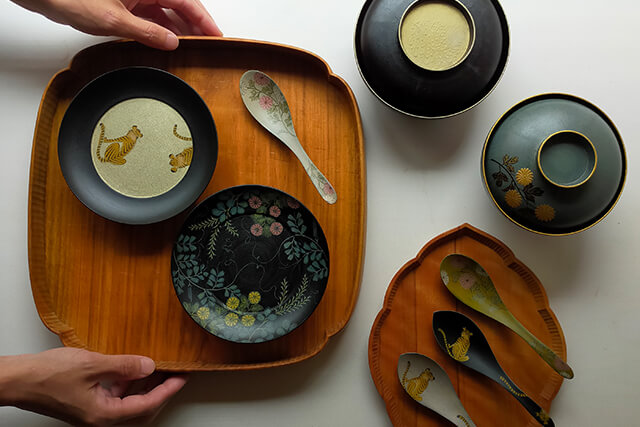
Design inspiration comes from “old things
Ochiai’s trays add a sophisticated atmosphere when combined with Japanese items such asearthenware,sake cups, and bamboo baskets for serving Japanese food, and an exquisite calmness when combined with Western taste such aslinen cloths,Western tableware, and wine glasses.
Such versatile designs are often inspired by “old things. For example, old pottery, antique tools, Yi Dynasty ceramics, and crafts, as well as non-woodworking objects, are also useful references. Ochiai often goes to antique markets in Kyoto, less than an hour away from his studio, to find inspiration.
Handcrafting a single solid piece of wood
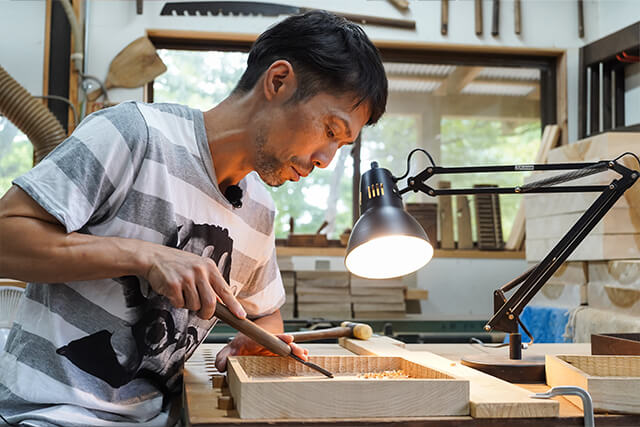
The distinctive feature of Ochiai’s work is the meticulous finishing, which is done by hand with a round chisel, leaving a solid hand-carved mark. Machines are used to cut large boards to the required size, rough carve, and form outlines, but the rest of the work is done by hand. He says he loves the “imperfect beauty” that only human hands can produce, which gives the piece a slight sense of fluctuation.
The key to shaving is ” to carve with the same tension. He says, “The key to carving is to carve with the same tension.” He says that the carving is finished beautifully when it is done in a straight line, with the same rhythm, thickness, and depth. He showed us the actual carving process, which was light and speedy. However, even on the same piece of board, there are hard and soft parts, so the carver adjusts the amount of force each time while carving. He repeats this process over and over again.
This might give the impression of monotonous work that requires a lot of patience, but Mr. Ochiai laughs, “My hands get sore, but strangely enough, I never get tired of it. He says it is interesting to see the grain patterns gradually take on a three-dimensional appearance as he carves. I could tell that Ochiai loves the time he spends working with his hands and facing the wood.
Perhaps it is because of this that when I look at or hold one of Mr. Ochiai’s wooden trays in my hands, I feel a sense of happiness that fills my heart with a sense of serenity. They are elegant, yet somehow gentle and warm.
Bringing out the individuality and expression of the wood
Another important point in Mr. Ochiai’s style is to ” bring out the original character of the wood.
Ochiai’s wooden trays are made of various types of wood, includingchestnut, cherry, zelkova, mizume, yellow cedar, and tabu. They come in a wide variety of colors, including deep black, soft beige, dark brown, reddish brown, and strong yellowish ochre. In some cases, oil finishes are used to bring out the original color of the wood, while other finishes such asiron-borne dyeing, ammonia smoke, and fuki-urushi (wiping lacquer) are used to add variety. They are constantly introducing new methods while considering the compatibility with the type of wood they are using.
No matter what type of finish is used, however, the artist insists on bringing out the individuality and expression of each type of wood. For this reason, the most commonly used finish is oil, which brings out the true color of the wood. When lacquer is used, the lacquer is not applied in a glossy lacquer finish, but rather is wiped off to finish the wood.
Splits and Knots are Also Part of the Wood’s Character
Ochiai also makes use ofknots andsplits in wood, which are often regarded as defects in wood, in his work. He says that when he cuts a large piece of wood and obtains 10 boards, there are usually 2 to 3 boards with knots or splits in them, but he wants to use them instead of throwing them away.
Knots, which are at the base of the branches of the tree, appear as a circular pattern when the wood is milled into boards. Although knotty boards are often avoided because they reduce the strength and appearance of the wood, Mr. Ochiai says they are interesting and tasteful. In fact, many people like trays with knot patterns and choose them.
The same goes for the cracks in the wood, which are used to accentuate the design of the piece. Compared to soup bowls and buckets, trays can be made without worrying about water leakage.
The Goodness of Things That Cannot Be Mass-Produced
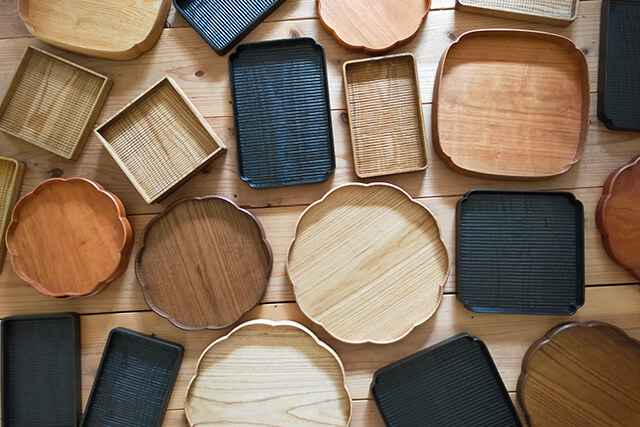
The style of production that makes full use of wood, which is now a precious commodity, and the beauty of daily utensils made with exquisite handcraftsmanship have the power to appeal to many people, especially in this age of information and goods.
Mr. Ochiai has held exhibitions throughout Japan, but his guides to these exhibitions include a request for a limit on the number of items that can be purchased. Because most of the process of carving is done by hand, it is difficult to mass-produce his works.
Therefore, the purchaser must face the individuality of each piece and find the one that is right for him or her. It is not difficult to imagine that this process creates an attachment to the piece and that it will be used with great care for a long time. It is only natural wood that can ” grow up ” with the depth of color as it is used.
The wooden trays created by Mr. Ochiai’s hands, while not perfect, have a certain beauty that makes us happy every time we use them, and they will be a small comfort in our hectic days. I felt as if I had seen an answer to the question of what crafts, which have been refined over time and through skill, can bring to people living in this era.



